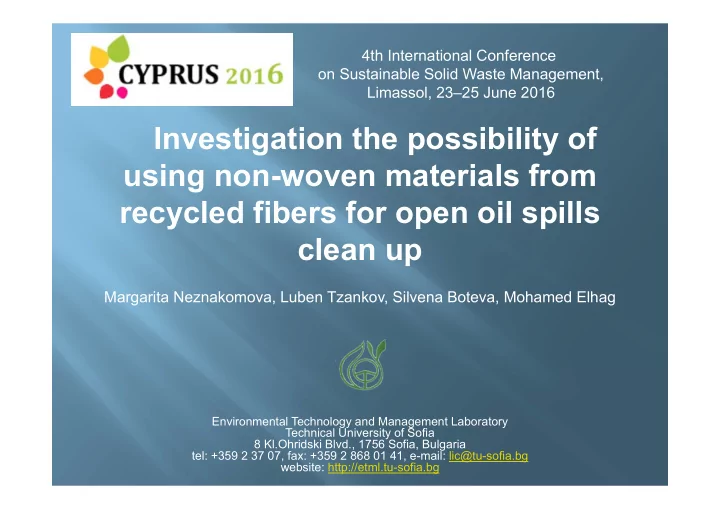

4th International Conference on Sustainable Solid Waste Management, Limassol, 23–25 June 2016 Investigation the possibility of using non-woven materials from recycled fibers for open oil spills clean up Margarita Neznakomova, Luben Tzankov, Silvena Boteva, Mohamed Elhag Environmental Technology and Management Laboratory Technical University of Sofia 8 Kl.Ohridski Blvd., 1756 Sofia, Bulgaria tel: +359 2 37 07, fax: +359 2 868 01 41, e-mail: lic@tu-sofia.bg website: http://etml.tu-sofia.bg
hydrocarbons come in the aquatic environment from a variety of natural and artificial sources; maritime transport - performance of standard operations, and smaller part of incidents; oil disperses rapidly over a huge area with large differences in thickness of the floating layer in a short time; impedes the use of any techniques for dealing with spills.
atmospheric destruction of oil - physical and chemical changes; performed under the action of natural forces - evaporation, dispersing, dissolving and precipitation and leads to the disappearance of oil from the water surface; water-oil emulsion - increase its viscosity, as the oil absorbs water up to four times its weight and promotes its resistance.
oil film - breaks the exchange of energy between the atmosphere and the seas; low surface tension, low gas permeability and other negative qualities adversely affect the water physical and chemical conditions; leading to flora and fauna destruction in the sea basin, contamination animals with carcinogenic hydrocarbons that subsequently fall into human body.
Methods for cleaning up oil spills Collection and recovery - long floating plastic or rubber enclosures (booms).
Sorbents hydrophobic and oleophilic, high degree of absorption and retention for a long period of time on the surface of the water, allow the extraction, reuse or recycle of absorbed oil
Recycling of textile waste Recovery and recycling of textiles ‐ of great benefit for the economy and for the environment ; textile materials are a problem for landfills ‐ synthetic fibers, degrade slowly and woolen during decomposition produce methane, which is one of the main culprits for the global warming; the need for new resources is reduced, pollution in the processing of new materials is avoided.
Materials and methods non ‐ woven materials obtained by needlepunching and stitch ‐ bonding method Materials Type Composition Parameters Material 1 stitch-bonding Wool 15% Step of stitching: 2.12 cm type Maliwatt Cotton 18% Length of thread in 1 cm: 3.74 cm Viscose 20% Number of stitches in 1 cm: 3.2 Polyester 17% PAN 30% Stitch fiber - polyester 100% Material 2 stitch-bonding Wool 5% Step of stitching: 0.7 cm type Maliwatt Cotton 20% Length of thread in 1 cm: 3.26 cm Viscose 17% Number of stitches in 1 cm: 3 Polyester 23% PAN 35% Stitch fiber - polyester 100% Material 3 needle punched Wool 20% Frequency of needle-punching: 500 min -1 Cotton 20% Depth of needle-punching: 12 mm Viscose 20% Projection density: 15 needles/cm Polyester 20% PAN 15% Polyamide 5% Material 4 needle punched 100% recovered wool Frequency of needle-punching: 800 min -1 Depth of needle-punching: 10 mm Projection density: 50 needles/cm
Material 1 Material 2 Material 4 Material 3
seawater - from the Black Sea in the Bourgas area; two types of oil - mineral motor oil OMV Austroil SAE 15W/40 and waste motor oil collected from oil change workshop; developed methodology in a laboratory using different amounts of pure mineral and waste oil in static conditions and agitation and residence time of the samples in the suspension from 10 to 30 min suspension used -100 ml seawater and 2 ml oil; degree of sinking - determined after a period of 48 hours; characterized materials - by determining the thickness, area and volume weight, air permeability; retention and extraction of oil from the suspension - determined by weight after drying 4 hours at 105 о С with blasting.
Results and discussion Thickness of used fibrous sorbents Volume density
Mass per unit area Coefficient of air permeability
Degree of adsorption of pure oil under agitation under static conditions
Degree of adsorption of waste oil under static conditions under agitation
Amount of adsorbed pollutant under agitation under static conditions
Results from combustion of waste samples Heat of combustion, kcal/kg Unprocessed Processed Material material material Material 1 5754 ± 30 30 015 ± 30 Material 2 7399 ± 30 31 452 ± 30 Material 3 7260 ± 30 31 361 ± 30 Material 4 8122 ± 30 34 365 ± 30
Conclusions As a result of tests carried out it has been found that the stitch- nded nonwoven materials have better ability to retain oil in mparison to needle-punched, because of the greater amount of free rous surface. The use of waste fibers mixtures with a higher content of PAN is ore effective for absorbents of petroleum. After use of the sorbents, their calorific value increases and erefore can be used as an energy source. But due to changing the de of the waste they have to be burned in special facilities, such as nnel kilns. Depending on the fiber composition, textile sorbents sink after ferent periods of stay in the water due to the amount included drophilic fibers, but these studies continue in order to provide escription for the way and time of use of non-woven blankets from generated fibers.
THANK YOU FOR YOUR ATTENTION ! project № BG161PO003-1.1.05 – 0261 / 15.02.2013 “Filter media of nonwovens”, developed by E- AR Ltd. is funded under the Operational Program “Development of the Competitiveness of rian Economy” 2007-2013, cofinanced by the European Union through the European Regional opment Fund and the national budget of the Republic of Bulgaria.
Recommend
More recommend